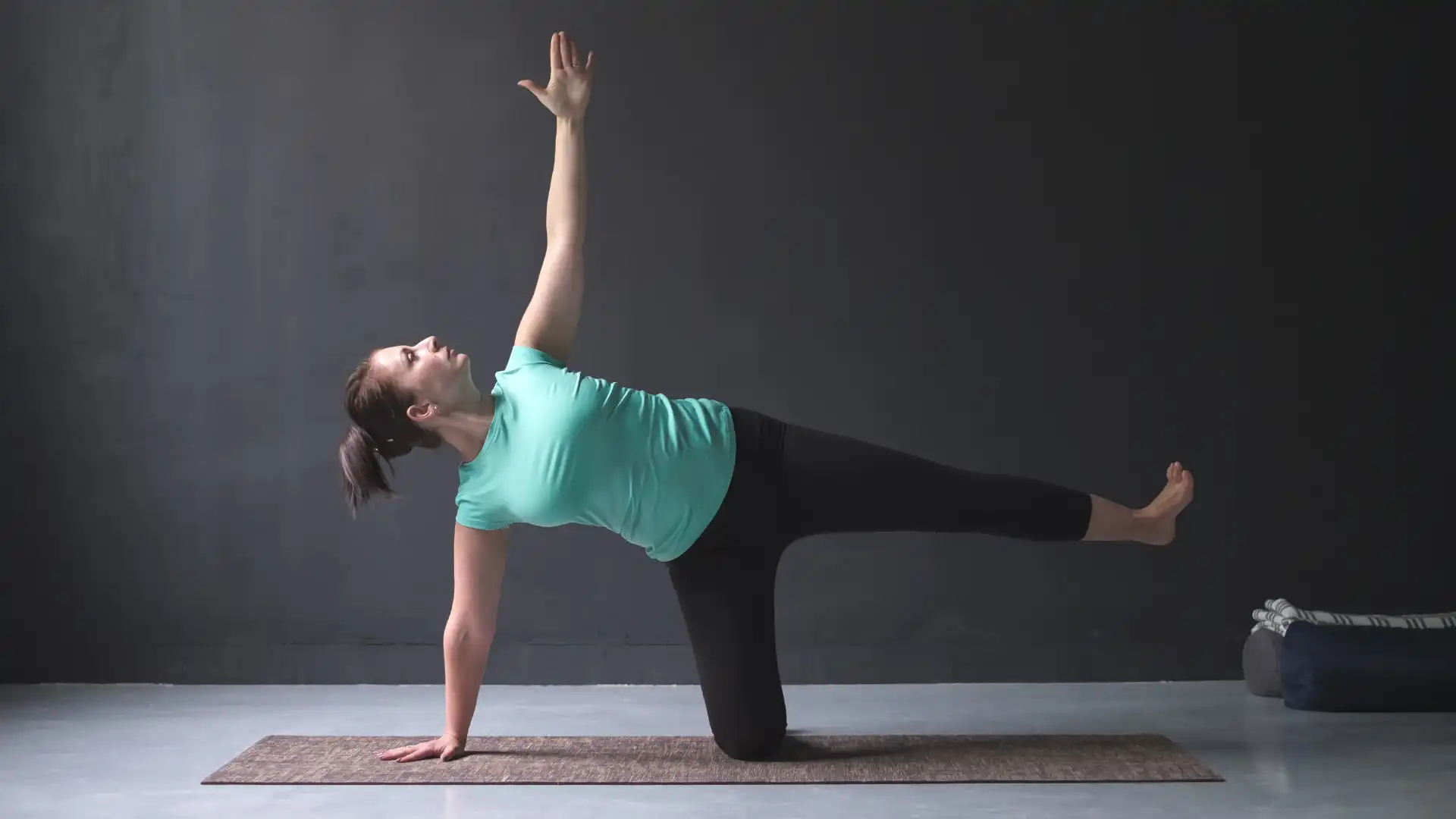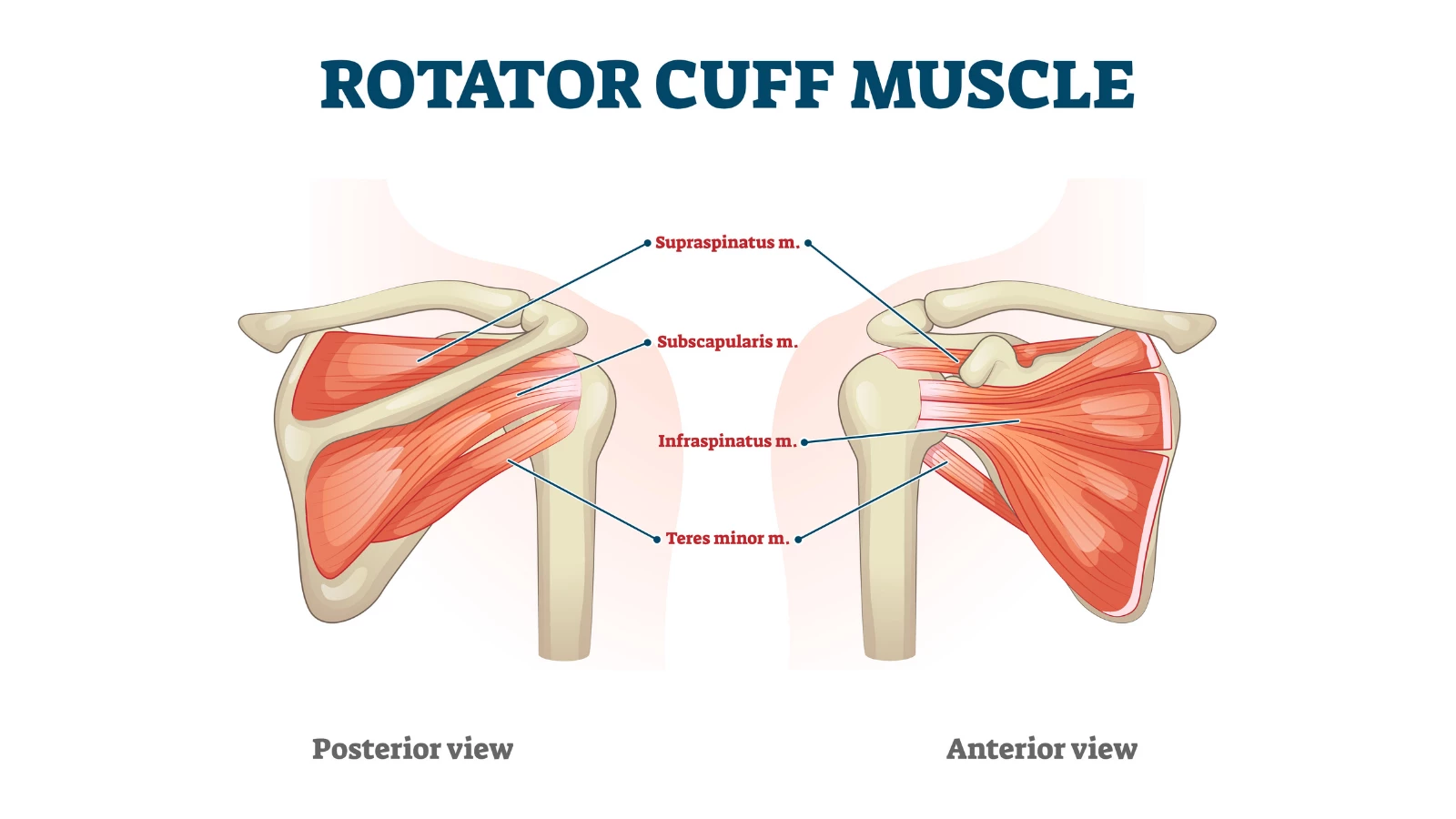4 Yoga Poses to Strengthen the 4 Muscles of the Rotator Cuff

Article At A Glance
With regular practice, these four yoga poses will help strengthen and stabilize the rotator cuff muscles to help prevent pain and injuries. It’s always wise to start slow and practice consistently to maximize your results.
The shoulder’s rotator cuff is a group of four separate muscles that work together to create a continuous cuff or sleeve around the head of the humerus (the upper arm bone). This cuff of muscles juggles the humerus’s position inside the glenoid fossa (the shoulder socket).
Our shoulders are inherently mobile. They’re a whole complex of three (or some anatomists say four) joints that collectively give the shoulders a vast range of motion in all planes and directions. The glenohumeral joint (where the upper arm bone meets the shoulder socket—what most people think of as the “shoulder” joint) is a synovial ball-and-socket joint that allows for an incredible range of motion.
We often think of yoga as being great for stretching our muscles to create flexibility and mobility. And while yoga is excellent for doing just that, it is also a powerful tool to encourage strength and stability within our bodies as well.
Since the glenohumeral joint is already inherently mobile, we don’t typically need to work on creating a range of motion here (unless there is injury or pathology). What we do need to focus on, especially during our yoga practice, is creating stability at these joints. This is because these mobile joints are not inherently designed to bear weight—as they are so often called upon to do in a yoga practice.
What Are the Rotator Cuff Muscles?
The rotator cuff is comprised of four separate muscles that connect the scapula (shoulder blade) to the humerus (upper arm bone):
- Subscapularis
- Supraspinatus
- Infraspinatus
- Teres minor

The subscapularis lives on the anterior surface of the scapula and connects to the very head of the humerus. Its primary role is to stabilize the humerus in its position within the shoulder socket. In its movement capacity, it helps with the internal rotation of the humerus.
The supraspinatus lives superior to what is called the spine of the scapula (a bony protrusion toward the top third of the shoulder blade) on the posterior surface and also connects to the head of the humerus. The supraspinatus is primarily a humeral stabilizer. In its movement capacity, it helps to initiate abduction of the arm.
The infraspinatus and teres minor are two very similar muscles that work almost as sidekicks. The infraspinatus is larger, and the teres minor is like his little brother following along with everything he does. The infraspinatus and teres minor live inferior to the spine of the scapula, on its posterior surface, and connect to the head of the humerus. Same as all muscles of the rotator cuff, their primary function is to stabilize the humerus in its position in the shoulder socket. In their movement capacity, they help with the external rotation of the humerus.
All of these muscles are deep muscles, meaning they sit closer to bone and farther away from the skin of the body. Deep muscles are primarily stabilizers, whereas superficial muscles tend to be bigger and have longer levers for more movements.
Because these deep muscles of the rotator cuff barely cross the shoulder joint, their main function is not movement—it’s stability. So all of their movement abilities will be quite subtle compared to their abilities to stabilize and support the bone structure.
How to Strengthen the Rotator Cuff with These 4 Yoga Poses
It’s not especially important to have a stabilized position of the shoulder joint when we’re living our normal lives. We actually want mobility in these joints for daily-life actions such as reaching the top cabinet in the kitchen or grabbing something from the back seat of a car.
But when we practice yoga and start to bear weight in our arms, it’s important to create a stable position in these joints so that they support the load of our body weight and keep the joints healthy. The following four postures help to strengthen the muscles of the rotator cuff so that we can safely add load to our arms.
1. Cow Face Arms (Gomukhasana Arms) to Stretch and Strengthen

This posture is excellent for the rotator cuff in general as it stretches and strengthens the whole group simultaneously by creating external rotation in the upper arm, internal rotation in the lower arm, and abduction in both arms to move into the shape.
You may wish to have a yoga strap or towel nearby for this pose.
- Start seated in any comfortable position. Elongate your spine by rooting down through your sit bones and stretching up through the crown of your head.
- Reach your right arm out wide and then up toward the sky and bend your elbow deeply. Take hold of your right elbow with your left hand and very gently draw your right arm closer toward the midline of your body behind your head. Mindfully lean the weight of your head back against your arm for a bit of tactile feedback.
- Release your left arm and sweep it open out wide toward the side of your mat. Turn your palm to face back behind you. Then bend your elbow deeply, drawing it in toward your torso, and slide the back of your left hand up your back as far as you can reach.
- Interlace your fingers behind your back. If your hands don’t touch, release your right arm temporarily and hold a yoga strap in your right hand, return your arm to the Cow Face position, and then dangle the strap behind your back and grab the other end with your left hand.
- Maintain the length you created in your spine. Ever so subtly, hug your lower ribs toward your back body and press the weight of your spine back against your hands. Avoid rounding your spine or tucking your chin to draw your hands closer toward each other.
- Pause and hold for a few deep breaths, and when you’re ready, release and switch sides.
2. Bound Warrior Pose (Baddha Virabhadrasana)

Similar to Gomukhasana binds work the muscles of the rotator cuff in their movement capacities to both strengthen and stretch simultaneously. In this bind, the lower arm is in internal rotation, the upper arm is in external rotation, and slight abduction is needed to initiate the shape.
Again, you may wish to have a strap or towel nearby for support.
- Start in Warrior II Pose (Virabhadrasana II) alignment with your right foot forward.
- Lean the weight of your torso toward your right leg and rest your right elbow on your right knee. Actively press down against your thigh and resist that energy by pressing your thigh into your arm to lift and lengthen both sides of your waistline. Spiral and rotate your chest to face toward the left. Strongly activate your core.
- Reach your left arm toward the sky and turn your palm to face behind you with your pinky finger closest to your face. Sweep your left arm behind your back and bend your elbow deeply. Either press the back of your hand against the back of your pelvis or loop your fingers around your right thigh.
- Keep the stability in your core and the length on the right side body, and slightly lean the weight of your torso farther toward the right and down toward the floor until you can slide your right arm underneath your right knee. Bend your elbow deeply and reach your right hand back up on the opposite side of your right thigh.
- Either hold a strap between your hands or interlace your fingers behind your back.
- Re-establish your foundation as needed by rooting down into your feet, elongating your spine, and rotating your chest open. Roll your left shoulder open and back to rotate it externally, and spiral your torso open more toward the long edge of your mat. Roll your right shoulder forward and down to internally rotate it in order to allow your arm to reach farther under your leg.
- Hold for a few deep breaths and then release and repeat on the other side.
3. Tabletop Pose (Bharmanasana) for Starting Weight-Bearing

As you start to bear weight in your arms, shoulder stability becomes infinitely more important. Tabletop Pose is a good place to start with weight-bearing because it doesn’t add too much weight, but it does add enough weight that it can build shoulder stability and, thus, activate and strengthen the rotator cuff.
- Start sitting on your heels (or on a yoga block or bolster) in Diamond Pose (Vajrasana) and stretch your arms forward in front of you at roughly the height and width of your shoulders.
- Extend your wrists, point your palms forward and your fingers upward in front of you, and spread your fingers wide.
- Actively press your palms forward in space as if trying to press against the wall in front of you.
- Plug your upper arm bones in toward their sockets by hugging them in and down on a diagonal line toward the midline of your body.
- Without movement, energetically squeeze your arms toward each other.
- Ever so slightly, broaden your chest and make your collarbones “smile.”
- Keep all of this activation around your shoulder girdle, and lift your hips to release your hands to the floor in front of you so that they align roughly under your shoulders and your knees roughly under your hips (hands-and-knees position).
- Maintain this engagement in your shoulders as you activate and stabilize your core.
- Hold a few deep breaths, then relax and repeat a few times to build strength.
4. Plank Pose (Phalakasana) for Strong Weight-bearing

Plank Pose is a strong weight-bearing position that adds more load than Tabletop Pose to further stabilize and strengthen the rotator cuff.
- Start in Tabletop Pose and follow the instructions above to stabilize and activate the entire shoulder complex (including the rotator cuff).
- Tuck your toes under and lift your knees off the floor. Walk your feet back behind you until you create a long, straight line—like a plank—in your body from head to toe.
- Energetically kick back through your heels and squeeze your legs in toward the midline of your body. Corset your waistline and draw your navel in and up. Keep the back of your neck long and your head in a neutral position. Root down against your hands as if pressing the floor away from you. Hug your upper arm bones in toward their sockets. Energetically magnetize your arms toward each other. Subtly broaden your chest.
- Maintain all of these actions for a few deep breaths, then pause and repeat a few more times to build strength in your shoulder girdle.
It’s Wise to Strengthen the Rotator Cuff for Your Yoga Practice
The rotator cuff is a key group of muscles that work along with others to create stability around the very mobile shoulder complex. When we bear weight on our hands, as we often do in yoga practice, it’s important to recruit these deep muscles to create stability and strength around our shoulder joints to protect and support them.
As we add more and more load to these joints, we need to be able to stabilize their position even further. So try these four postures to build strength in the rotator cuff, so you can gradually add more weight in your practice. And if you choose, you can eventually find shoulder stability in greater load-bearing positions like Handstand Pose (Adho Mukha Vrksasana).
Shoulder stability is not needed in our everyday lives, but when we flip ourselves upside down on our yoga mats, shoulder stability is crucial to maintaining health and integrity in our shoulder joints. The rotator cuff isn’t the only group of muscles that needs to be strong and active to create shoulder stability, but it is an important group to help bear the load of our body weight when we practice.
So, strengthen and stabilize these four deep muscles to have a more secure and active shoulder girdle as you bear weight. Your body will very likely thank you.
Also, read...
Connect Your Cuff, Save Your Wrists in Plank
Related courses

Leah Sugerman is a yoga teacher, writer, and passionate world traveler. An eternally grateful student, she has trained in countless schools and traditions of the practice. She teaches a fusion of the styles she has studied with a strong emphasis on breath, alignment, and anatomical integrity. Leah teaches workshops, retreats, and trainings, both internationally and online. For more information, visit www.leahsugerman.com.



